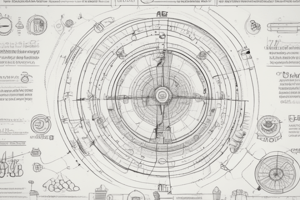Podcast
Questions and Answers
What is the purpose of data cleansing in research?
What is the purpose of data cleansing in research?
- To conduct numerical calculations on sets of numbers
- To convert raw data into a format suitable for processing
- To summarize large amounts of data visually or numerically
- To remove incorrect, irrelevant, or duplicate records from datasets (correct)
Which of the following is NOT an example of a qualitative research method?
Which of the following is NOT an example of a qualitative research method?
- Descriptive statistics (correct)
- Focus groups
- Case studies
- Ethnography
What is the purpose of sampling in research?
What is the purpose of sampling in research?
- To obtain a representative subset of a population for analysis (correct)
- To summarize large amounts of data visually or numerically
- To remove incorrect, irrelevant, or duplicate records from datasets
- To convert raw data into a format suitable for processing
Which data analysis technique involves extracting valuable knowledge from raw data using numerical calculations and probabilistic reasoning?
Which data analysis technique involves extracting valuable knowledge from raw data using numerical calculations and probabilistic reasoning?
What does data transformation involve in research?
What does data transformation involve in research?
Flashcards
Questionnaire
Questionnaire
A commonly used tool for collecting quantitative data. Effective questionnaires measure one concept per item and reflect their intended meaning.
Qualitative Research
Qualitative Research
A research approach valuing depth over breadth. It explores patterns, themes, and underlying causes of human behavior.
Data Cleansing
Data Cleansing
The process of removing incorrect or duplicate records from datasets, ensuring data accuracy.
Sampling
Sampling
Signup and view all the flashcards
Data Analysis Techniques
Data Analysis Techniques
Signup and view all the flashcards
Study Notes
Data Collection Methods and Techniques
Data is the foundation of many decisions made by businesses, governments, nonprofits, academia, and individuals. It can help us make better choices, enhance our understanding of complex phenomena, and improve processes and systems. In this context, effective data collection through surveys, interviews, observations, or experiments ensures accurate and reliable information, which forms the basis of decision making. Here we explore some key elements involved in executing these data collection efforts:
Questionnaire Design
Questionnaires are one of the most commonly used tools for collecting quantitative data from respondents. To create a well-designed questionnaire, it's essential to consider factors such as response rates, reliability, validity, and item wording. Additionally, if you want your questionnaire to produce meaningful results, ensure that each item measures only one concept and reflects its intended meaning.
Qualitative Research Methods
In contrast to quantitative approaches where data is collected using scales, indicators, and statistical tests, qualitative research involves a more interpretive process. This methodology values depth over breadth, exploring patterns, themes, motifs, and textures while seeking to understand the underlying causes of human behavior, thoughts, feelings, and interactions with others. Examples of qualitative research methods include focus groups, ethnography, grounded theory, case studies, and narrative analysis.
Data Validation
After gathering data, whether through online surveys, face-to-face interviews, or other means, it must be checked for errors and verified before being analyzed. Data cleansing refers to the process of removing incorrect, irrelevant, or duplicate records from datasets. Conversely, data transformation converts raw data into a format suitable for further processing and modeling.
Sampling Methods
Sampling, also known as sample selection, is a technique used to obtain a representative subset of a population so that conclusions drawn from the sample can apply to the wider group. There are several types of samples: convenience, cluster, quota, stratified, systematic, random, and snowball samples. Each has its own merit depending upon the scope, objective, and resources of the study.
Data Analysis Techniques
Once data has been successfully gathered and validated, various analytical techniques can be applied to it. For example, statistics involve numerical calculations and probabilistic reasoning on sets of numbers; descriptive statistics summarize large amounts of data visually or numerically, providing insights into central tendencies, spreads, and distributions within a dataset. Other techniques include regression analysis, factor analysis, correlation analysis, and time series analysis. These methods extract valuable knowledge from raw data that otherwise might remain unseen due to its sheer volume.
Effectively combining all these components leads to more robust research findings. Enhanced data quality allows researchers to draw stronger conclusions relevant to their goals, thereby optimizing outcomes based on evidence rather than opinion.
Studying That Suits You
Use AI to generate personalized quizzes and flashcards to suit your learning preferences.




